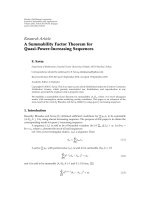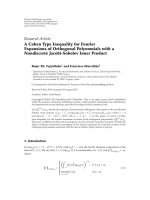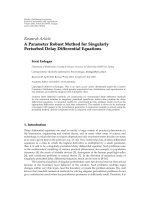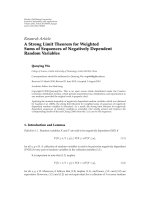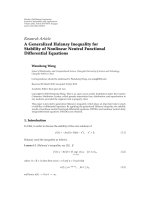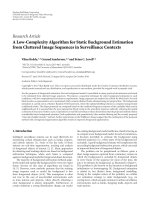Báo cáo hóa học: " Research Article A Summability Factor Theorem for Quasi-Power-Increasing Sequences" pdf
Bạn đang xem bản rút gọn của tài liệu. Xem và tải ngay bản đầy đủ của tài liệu tại đây (484.42 KB, 10 trang )
Hindawi Publishing Corporation
Journal of Inequalities and Applications
Volume 2010, Article ID 105136, 10 pages
doi:10.1155/2010/105136
Research Article
A Summability Factor Theorem for
Quasi-Power-Increasing Sequences
E. Savas¸
Department of Mathematics,
˙
Istanbul Ticaret University,
¨
Usk
¨
udar, 34378
˙
Istanbul, Turkey
Correspondence should be addressed to E. Savas¸,
Received 23 June 2010; Revised 3 September 2010; Accepted 15 September 2010
Academic Editor: J. Szabados
Copyright q 2010 E. Savas¸. This is an open access article distributed under the Creative Commons
Attribution License, which permits unrestricted use, distribution, and reproduction in any
medium, provided the original work is properly cited.
We establish a summability factor theorem for summability |A, δ|
k
,whereA is lower triangular
matrix with nonnegative entries satisfying certain conditions. This paper is an extension of the
main result of the work by Rhoades and Savas¸ 2006 by using quasi f-increasing sequences.
1. Introduction
Recently, Rhoades and Savas¸ 1 obtained sufficient conditions for
a
n
λ
n
to be summable
|A, δ|
k
, k ≥ 1 by using almost increasing sequence. The purpose of this paper is to obtain the
corresponding result for quasi f-increasing sequence.
A sequence {λ
n
} is said to be of bounded variation bv if
n
|Δλ
n
| < ∞. Let bv
0
bv ∩ c
0
, where c
0
denotes the set of all null sequences.
Let A be a lower triangular matrix, {s
n
} a sequence. Then
A
n
:
n
ν0
a
nν
s
ν
. 1.1
A series
a
n
, with partial sums s
n
, is said to be summable |A|
k
,k ≥ 1if
∞
n1
n
k−1
|
A
n
− A
n−1
|
k
< ∞,
1.2
and it is said to be summable |A, δ|
k
,k ≥ 1andδ ≥ 0ifsee, 2
∞
n1
n
δkk−1
|
A
n
− A
n−1
|
k
< ∞.
1.3
2 Journal of Inequalities and Applications
A positive sequence {b
n
} is said to be an almost increasing sequence if there exist an
increasing sequence {c
n
} and positive constants A and B such that Ac
n
≤ b
n
≤ Bc
n
see, 3.
Obviously, every increasing sequence is almost increasing. However, the converse need not
be true as can be seen by taking the example, say b
n
e
−1
n
n.
A positive sequence γ : {γ
n
} is said to be a quasi β-power increasing sequence if there
exists a constant K Kβ, γ ≥ 1 such that
Kn
β
γ
n
≥ m
β
γ
m
1.4
holds for all n ≥ m ≥ 1. It should be noted that every almost increasing sequence is quasi
β-power increasing sequence for any nonnegative β, but the converse need not be true as can
be seen by taking an example, say γ
n
n
−β
for β>0 see, 4. A sequence satisfying 1.4 for
β 0 is called a quasi-increasing sequence. It is clear that if {γ
n
} is quasi β-power increasing
then {n
β
γ
n
} is quasi-increasing.
A positive sequence γ {γ
n
} is said to be a quasi-f-power increasing sequence if there
exists a constant K Kγ,f ≥ 1 such that Kf
n
γ
n
≥ f
m
γ
m
holds for all n ≥ m ≥ 1, where
f : {f
n
} {n
β
log n
μ
},μ>0, 0 <β<1, see, 5.
We may associate with A two lower triangular matrices
A and
A as follows:
a
nv
n
rv
a
nr
,n,v 0, 1, ,
a
nv
a
nv
− a
n−1,v
,n 1, 2, ,
1.5
where
a
00
a
00
a
00
. 1.6
Given any sequence {x
n
}, the notation x
n
O1 means that x
n
O1 and 1/x
n
O1. For any matrix entry a
nv
, Δ
v
a
nv
: a
nv
− a
n,v1
.
Rhoades and Savas¸ 1 proved the following theorem for |A, δ|
k
summability factors
of infinite series.
Theorem 1.1. Let {X
n
} be an almost increasing sequence and let {β
n
} and {λ
n
} be sequences such
that
i |Δλ
n
|≤β
n
,
ii lim β
n
0,
iii
∞
n1
n|Δβ
n
|X
n
< ∞,
iv |λ
n
|X
n
O1.
Let A be a lower triangular matrix with nonnegative entries satisfying
v na
nn
O1,
vi a
n−1,ν
≥ a
nν
for n ≥ ν 1,
vii
a
n0
1 for all n,
Journal of Inequalities and Applications 3
viii
n−1
ν1
a
νν
a
nν1
Oa
nn
,
ix
m1
nν1
n
δk
|Δ
ν
a
nν
| Oν
δk
a
νν
and
x
m1
nν1
n
δk
a
nν1
Oν
δk
.
If
xi
m
n1
n
δk−1
|t
n
|
k
OX
m
,wheret
n
:1/n 1
n
k1
ka
k
,
then the series
a
n
λ
n
is summable |A, δ|
k
,k ≥ 1.
It should be noted that, if {X
n
} is an almost increasing sequence, then condition iv
implies that the sequence {λ
n
} is bounded. However, if {X
n
} is a quasi β-power increasing
sequence or a quasi f-increasing sequence, iv does not imply that λ is bounded. For
example, the sequence {X
m
} defined by X
m
m
−β
is trivially a quasi β-power increasing
sequence for each β>0. If λ {m
δ
}, for any 0 <δ<β,then λ
m
X
m
m
δ−β
O1, but λ is not
bounded, see, 6, 7.
The purpose of this paper is to prove a theorem by using quasi f-increasing sequences.
We show that the crucial condition of our proof, {λ
n
}∈bv
0
, can be deduced from another
condition of the theorem.
2. The Main Results
We now will prove the following theorems.
Theorem 2.1. Let A satisfy conditions (v)–(x) and let {β
n
} and {λ
n
} be sequences satisfying
conditions (i) and (ii) of Theorem 1.1 and
m
n1
λ
n
o
m
,m−→ ∞ . 2.1
If {X
n
} is a quasi f-increasing sequence and condition (xi) and
∞
n1
nX
n
β, μ
Δβ
n
< ∞ 2.2
are satisfied then the series
a
n
λ
n
is summable |A, δ|
k
, k ≥ 1, where {f
n
} : {n
β
log n
μ
},μ ≥
0, 0 ≤ β<1, and X
n
β, μ :n
β
log n
μ
X
n
.
The following theorem is the special case of Theorem 2.1 for μ 0.
Theorem 2.2. Let A satisfy conditions (v)–(x) and let {β
n
} and {λ
n
} be sequences satisfying
conditions (i), (ii), and 2.1.If{X
n
} is a quasi β-power increasing sequence for some 0 ≤ β<1
and conditions (xi) and
∞
n1
nX
n
β
Δβ
n
< ∞ 2.3
are satisfied, where X
n
β :n
β
X
n
, then the series
a
n
λ
n
is summable |A, δ|
k
, k ≥ 1.
4 Journal of Inequalities and Applications
Remark 2.3. The conditions {λ
n
}∈bv
0
, and iv do not appear among the conditions of
Theorems 2.1 and 2.2.ByLemma 3.3, under the conditions on {X
n
}, {β
n
},and{λ
n
} as taken
in the statement of the Theorem 2.1, also in the statement of Theorem 2.2 with the special case
μ 0, conditions {λ
n
}∈bv
0
and iv hold.
3. Lemmas
We will need the following lemmas for the proof of our main Theorem 2.1.
Lemma 3.1 see 8. Let {ϕ
n
} be a sequence of real numbers and denote
Φ
n
:
n
k1
ϕ
k
, Ψ
n
:
∞
kn
Δϕ
k
.
3.1
If Φ
n
on then there exists a natural number N such that
ϕ
n
≤ 2Ψ
n
3.2
for all n ≥ N.
Lemma 3.2 see 9. If {X
n
} is a quasi f-increasing sequence, where {f
n
} {n
β
log n
μ
},μ ≥
0, 0 ≤ β<1, then conditions 2.1 of Theorem 2.1,
m
n1
|
Δλ
n
|
o
m
,m−→ ∞ ,
3.3
∞
n1
nX
n
β, μ
|
Δ
|
Δλ
n
||
< ∞,
3.4
where X
n
β, μn
β
log n
μ
X
n
, imply conditions (iv) and
λ
n
−→ 0,n−→ ∞ . 3.5
Lemma 3.3 see 7. If {X
n
} is a quasi f-increasing sequence, where {f
n
} {n
β
log n
μ
},μ ≥
0, 0 ≤ β<1, then under conditions (i), (ii), 2.1 , and 2.2, conditions (iv) and 3.5 are satisfied.
Lemma 3.4 see 7. Let {X
n
} be a quasi f-increasing sequence, where {f
n
} {n
β
log n
μ
}, μ ≥
0, 0 ≤ β<1. If conditions (i), (ii), and 2.2 are satisfied, then
nβ
n
X
n
O
1
, 3.6
∞
n1
β
n
X
n
< ∞.
3.7
Journal of Inequalities and Applications 5
4. Proof of Theorem 2.1
Proof. Let y
n
be the nth term of the A transform of the partial sums of
n
i0
λ
i
a
i
. Then we
have
y
n
:
n
i0
a
ni
s
i
n
i0
a
ni
i
ν0
λ
ν
a
ν
n
ν0
λ
ν
a
ν
n
iν
a
ni
n
ν0
a
nν
λ
ν
a
ν
,
4.1
and, for n ≥ 1, we have
Y
n
: y
n
− y
n−1
n
ν0
a
nν
λ
ν
a
ν
.
4.2
We may write noting that vii implies that a
n0
0,
Y
n
n
ν1
a
nν
λ
ν
ν
νa
ν
n
ν1
a
nν
λ
ν
ν
ν
r1
ra
r
−
ν−1
r1
ra
r
n−1
ν1
Δ
ν
a
nν
λ
ν
ν
ν
r1
ra
r
a
nn
λ
n
n
n
r1
ra
r
n−1
ν1
Δ
ν
a
nν
λ
ν
ν 1
ν
t
ν
n−1
ν1
a
n,ν1
Δλ
ν
ν 1
ν
t
ν
n−1
ν1
a
n,ν1
λ
ν1
1
ν
t
ν
n 1
a
nn
λ
n
t
n
n
T
n1
T
n2
T
n3
T
n4
, say.
4.3
To complete the proof it is sufficient, by Minkowski’s inequality, to show that
∞
n1
n
δkk−1
|
T
nr
|
k
< ∞, for r 1, 2, 3, 4.
4.4
From the definition of
A and using vi and vii it follows that
a
n,ν1
≥ 0. 4.5
6 Journal of Inequalities and Applications
Using H
¨
older’s inequality
I
1
:
m
n1
n
δkk−1
|
T
n1
|
k
m
n1
n
δkk−1
n−1
ν1
Δ
ν
a
nν
λ
ν
ν 1
ν
t
ν
k
O
1
m1
n1
n
δkk−1
n−1
ν1
|
Δ
ν
a
nν
||
λ
ν
||
t
ν
|
k
O
1
m1
n1
n
δkk−1
n−1
ν1
|
Δ
ν
a
nν
||
λ
ν
|
k
|
t
ν
|
k
n−1
ν1
|
Δ
ν
a
nν
|
k−1
,
Δ
ν
a
nν
a
nν
− a
n,ν1
a
nν
− a
n−1,ν
− a
n,ν1
a
n−1,ν1
a
nν
− a
n−1,ν
≤ 0.
4.6
Thus, using vii,
n−1
ν0
|
Δ
ν
a
nν
|
n−1
ν0
a
n−1,ν
− a
nν
1 − 1 a
nn
a
nn
.
4.7
Since λ
n
is bounded by Lemma 3.3,usingv, ix, xi, i, and condition 3.7 of Lemma 3.4
I
1
O
1
m1
n1
n
δk
na
nn
k−1
n−1
ν1
|
λ
ν
|
k
|
t
ν
|
k
|
Δ
ν
a
nν
|
O
1
m1
n1
n
δk
n−1
ν1
|
λ
ν
|
k−1
|
λ
ν
||
Δ
ν
a
nν
||
t
ν
|
k
O
1
m
ν1
|
λ
ν
||
t
ν
|
k
m1
nν1
n
δk
|
Δ
ν
a
nν
|
O
1
m
ν1
ν
δk
|
λ
ν
|
a
νν
|
t
ν
|
k
O
1
m
ν1
ν
δk−1
|
λ
ν
||
t
ν
|
k
O
1
m−1
ν1
Δ
|
λ
ν
|
ν
r1
r
δk−1
|
t
r
|
k
|
λ
m
|
m
r1
r
δk−1
|
t
r
|
k
O
1
m−1
ν1
|
Δλ
ν
|
X
ν
O
1
|
λ
m
|
X
m
O
1
m
ν1
β
ν
X
ν
O
1
|
λ
m
|
X
m
O
1
.
4.8
Journal of Inequalities and Applications 7
Using H
¨
older’s inequality,
I
2
:
m1
n2
n
δkk−1
|
T
n2
|
k
m1
n2
n
δkk−1
n−1
ν1
a
n,ν1
Δλ
ν
ν 1
ν
t
ν
k
O
1
m1
n2
n
δkk−1
n−1
ν1
a
n,ν1
|
Δλ
ν
||
t
ν
|
k
O
1
m1
n2
n
δkk−1
n−1
ν1
|
Δλ
ν
||
t
ν
|
k
a
n,ν1
n−1
ν1
a
n,ν1
|
Δλ
ν
|
k−1
.
4.9
By Lemma 3.1, condition 3.3,inviewofLemma 3.3 implies that
∞
n1
|
Δλ
n
|
≤ 2
∞
n1
∞
kn
|
Δ
|
Δλ
k
||
2
∞
k1
|
Δ
|
Δλ
k
||
4.10
holds. Thus by Lemma 3.3, 3.4 implies that
∞
n1
|Δλ
n
| converges. Therefore, there exists a
positive constant M such that
∞
n1
|Δλ
n
|≤M and from the properties of matrix A,weobtain
n−1
ν1
a
n,ν1
|
Δλ
k
|
≤ Ma
nn
. 4.11
We have, using v and x,
I
2
O
1
m1
n2
n
δk
na
nn
k−1
n−1
ν1
a
n,ν1
β
ν
|
t
ν
|
k
O
1
m
ν1
β
ν
|
t
ν
|
k
m1
nν1
n
δk
a
n,ν1
.
4.12
Therefore,
I
2
O
1
m
ν1
ν
δk
β
ν
|
t
ν
|
k
O
1
m
ν1
νβ
ν
|
t
ν
|
k
ν
ν
δk
.
4.13
8 Journal of Inequalities and Applications
Using summation by parts, 2.2, xi, and condition 3.6 and 3.7 of Lemma 3.4
I
2
: O
1
m−1
ν1
Δ
νβ
ν
ν
r1
r
δk−1
|
t
r
|
k
O
1
mβ
m
m
r1
r
δk−1
|
t
r
|
k
O
1
m−1
ν1
ν
Δ
β
ν
X
ν
O
1
m−1
ν1
β
ν1
X
ν1
O
1
O
1
.
4.14
Using H
¨
older’s inequality and viii,
m1
n2
n
k−1
|
T
n3
|
k
m1
n2
n
δkk−1
n−1
ν1
a
n,ν1
λ
ν1
1
ν
t
ν
k
≤
m1
n2
n
δkk−1
n−1
ν1
|
λ
ν1
|
a
n,ν1
ν
|
t
ν
|
k
O
1
m1
n2
n
δkk−1
n−1
ν1
|
λ
ν1
|
a
n,ν1
|
t
ν
|
a
νν
k
O
1
m1
n2
n
δkk−1
n−1
ν1
|
λ
ν1
|
k
a
νν
|
t
ν
|
k
a
n,ν1
n−1
ν1
a
νν
|
a
n,ν1
|
k−1
.
4.15
Using boundedness of {λ
n
}, v, x, xi, Lemmas 3.3 and 3.4
I
3
O
1
m1
n2
n
δk
na
nn
k−1
n−1
ν1
|
λ
ν1
|
k
a
νν
|
t
ν
|
k
a
n,ν1
O
1
m
ν1
|
λ
ν1
|
a
νν
|
t
ν
|
k
m1
nν1
n
δk
a
n,ν1
O
1
m
ν1
|
λ
ν1
|
ν
δk
a
νν
|
t
ν
|
k
O
1
m
v1
|
λ
v1
|
va
vv
v
δk−1
|
t
v
|
k
O
1
m
v1
|
λ
v1
|
v
δk−1
|
t
v
|
k
.
4.16
Journal of Inequalities and Applications 9
Using summation by parts
I
3
O
1
m−1
v1
|
Δλ
v1
|
v
r1
r
δk−1
|
t
r
|
k
O
1
|
λ
m1
|
m
v1
v
δk−1
|
t
v
|
k
O
1
m−1
v1
|
Δλ
v1
|
v1
r1
r
δk−1
|
t
r
|
k
O
1
|
λ
m1
|
m1
v1
v
δk−1
|
t
v
|
k
O
1
m−1
v1
|
Δλ
v1
|
X
v1
O
1
|
λ
m1
|
X
m1
O
1
m−1
v1
β
v1
X
v1
O
1
|
λ
m1
|
X
m1
O
1
.
4.17
Finally, using boundedness of {λ
n
},andv we have
m
n1
n
δkk−1
|
T
n4
|
k
m
n1
n
δkk−1
n 1
a
nn
λ
n
t
n
n
k
O
1
m
n1
n
δk
a
nn
|
λ
n
||
t
n
|
k
O
1
,
4.18
as in the proof of I
1
.
5. Corollaries and Applications to Weighted Means
Setting δ 0inTheorem 2.1 and Theorem 2.2 yields the following two corollaries,
respectively.
Corollary 5.1. Let A satisfy conditions (v)–(viii) and let {β
n
} and {λ
n
} be sequences satisfying
conditions (i), (ii), and 2.1.If{X
n
} is a quasi f-increasing sequence, where {f
n
} :
{n
β
log n
μ
},μ≥ 0, 0 ≤ β<1, and conditions 2.2 and
m
n1
1
n
|
t
n
|
k
O
X
m
,m−→ ∞ , 5.1
are satisfied then the series
a
n
λ
n
is summable |A|
k
,k ≥ 1.
Proof. If we take δ 0inTheorem 2.1 then condition xi reduces condition 5.1.
Corollary 5.2. Let A satisfy conditions (v)–(viii) and let {β
n
} and {λ
n
} be sequences satisfying
conditions (i), (ii), and 2.1.If{X
n
} is a quasi β-power increasing sequence for some 0 ≤ β<1 and
conditions 2.3 and 5.1 are satisfied then the series
a
n
λ
n
is summable |A|
k
, k ≥ 1.
10 Journal of Inequalities and Applications
Corollary 5.3. Let {p
n
} be a positive sequence such that P
n
:
n
i0
p
i
→∞, as n →∞satisfies
np
n
O
P
n
, as n −→ ∞ , 5.2
m1
nv1
n
δk
p
n
P
n
P
n−1
O
v
δk
P
v
5.3
and let {β
n
} and {λ
n
} be sequences satisfying conditions (i), (ii), and 2.1.If{X
n
} is a quasi f-
increasing sequence, where {f
n
} : {n
β
log n
μ
}, μ ≥ 0, 0 ≤ β<1, and conditions (xi) and 2.2 are
satisfied then the series,
a
n
λ
n
is summable |N, p
n
,δ|
k
for k ≥ 1.
Proof. In Theorem 2.1,setA N,p
n
. Conditions i and ii of Corollary 5.3 are,
respectively, conditions i and ii of Theorem 2.1. Condition v becomes condition 5.2 and
conditions ix and x become condition 5.3 for weighted mean method. Conditions vi,
vii,andviii of Theorem 2.1 are automatically satisfied for any weighted mean method.
The following Corollary is the special case of Corollary 5.3 for μ 0.
Corollary 5.4. Let {p
n
} be a positive sequence satisfying 5.2, 5.3 and let {X
n
} be a quasi β-power
increasing sequence for some 0 ≤ β<1. Then under conditions (i), (ii), (xi), 2.1, and 2.3,
a
n
λ
n
is summable |N, p
n
,δ|
k
,k ≥ 1.
References
1 B. E. Rhoades and E. Savas¸, “A summability factor theorem for generalized absolute summability,”
Real Analysis Exchange, vol. 31, no. 2, pp. 355–363, 2006.
2 T. M. Flett, “On an extension of absolute summability and some theorems of Littlewood and Paley,”
Proceedings of the London Mathematical Society , vol. 7, pp. 113–141, 1957.
3 S. Alijancic and D. Arendelovic, “O-regularly varying functions,” Publications de l’Institut Math
´
ematique
, vol. 22, no. 36, pp. 5–22, 1977.
4 L. Leindler, “A new application of quasi power increasing sequences,” Publicationes Mathematicae
Debrecen, vol. 58, no. 4, pp. 791–796, 2001.
5 W. T. Sulaiman, “Extension on absolute summability factors of infinite series,” Journal of Mathematical
Analysis and Applications, vol. 322, no. 2, pp. 1224–1230, 2006.
6 E. Savas¸, “A note on generalized |A|
k
-summability factors for infinite series,” Journal of Inequalities and
Applications, vol. 2010, Article ID 814974, 10 pages, 2010.
7 E. Savas¸andH.S¸evli, “A recent note on quasi-power increasing sequence for generalized absolute
summability,” Journal of Inequalities and Applications, vol. 2009, Article ID 675403, 10 pages, 2009.
8 L. Leindler, “A note on the absolute Riesz summability factors,” Journal of Inequalities in Pure and Applied
Mathematics, vol. 6, no. 4, article 96, 2005.
9 H. S¸evli and L. Leindler, “On the absolute summability factors of infinite series involving quasi-power-
increasing sequences,” Computers & Mathematics with Applications, vol. 57, no. 5, pp. 702–709, 2009.



